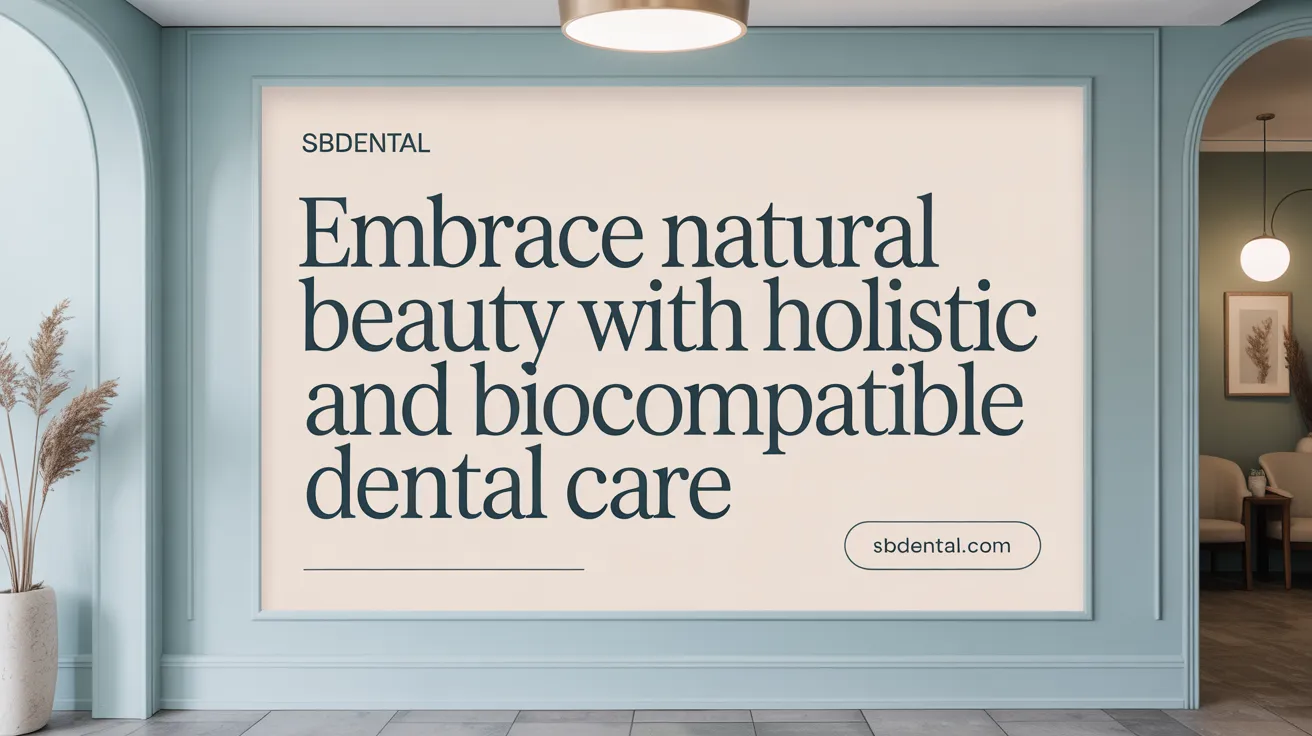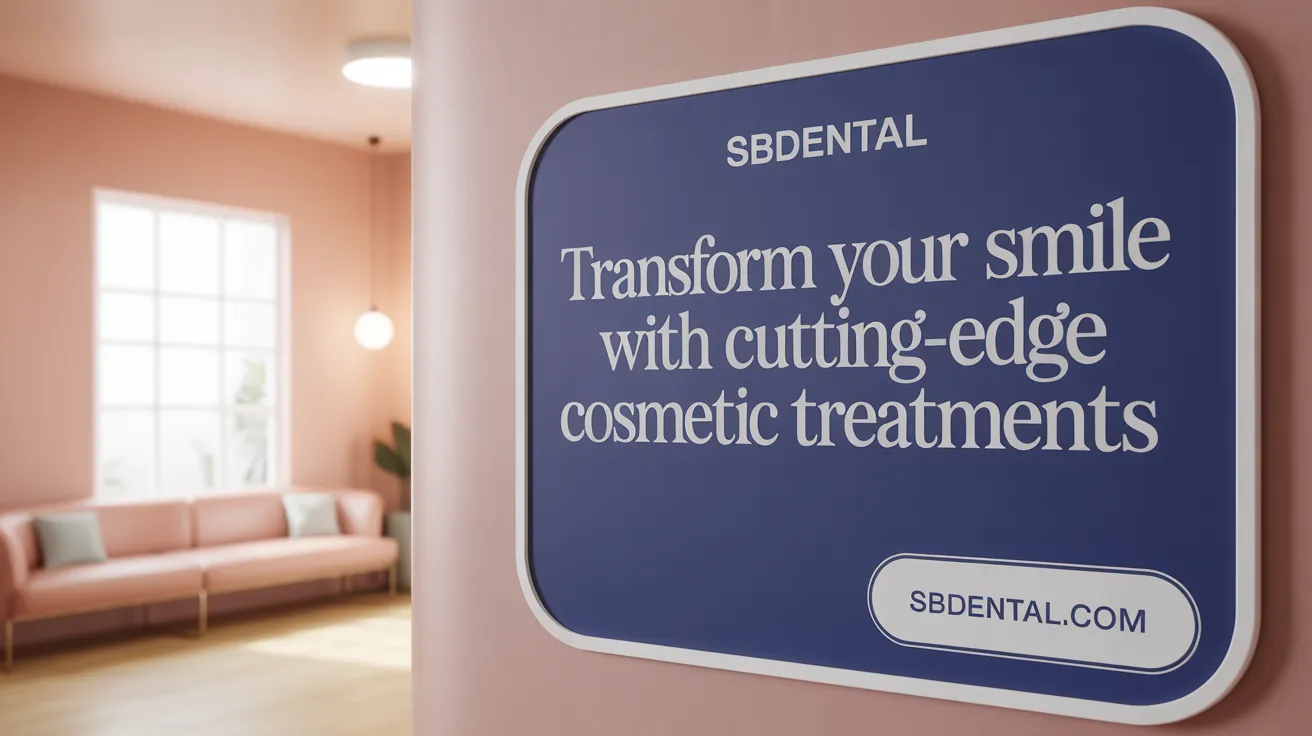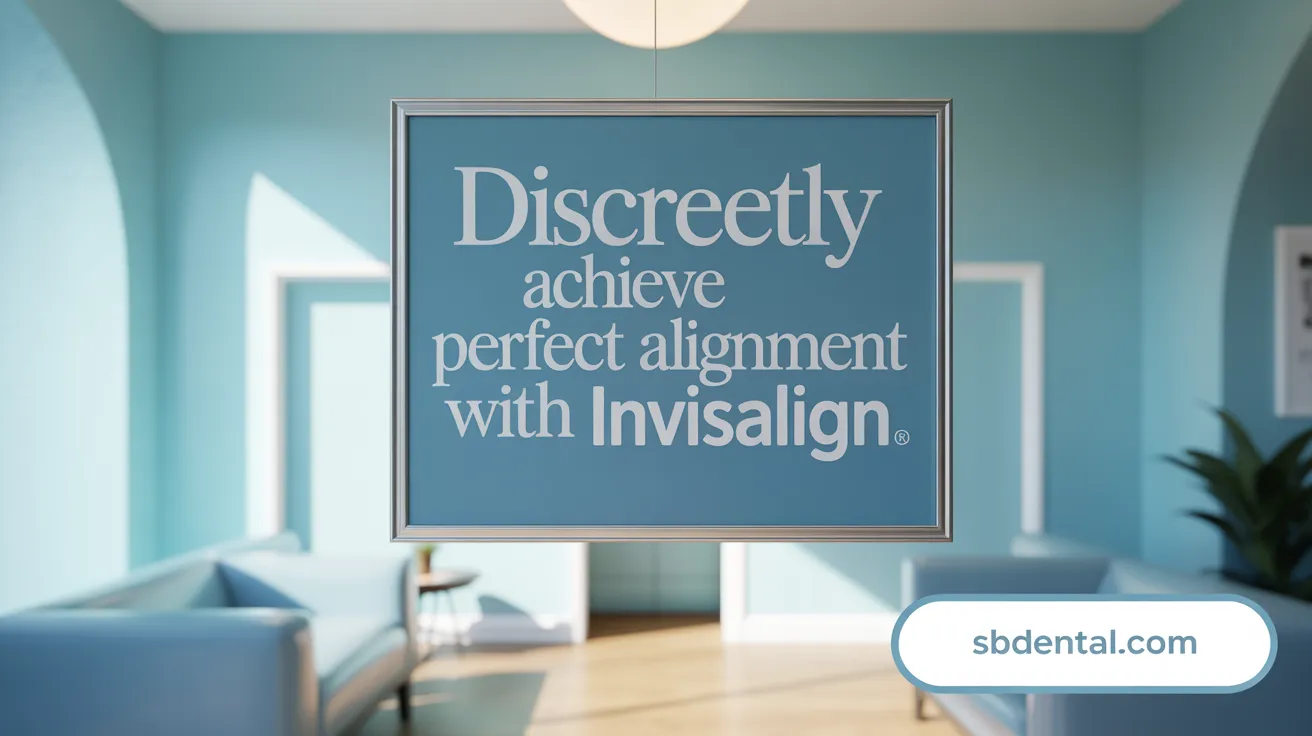Embrace Your Natural Smile with Modern Cosmetic Dentistry
A captivating smile can enhance confidence, improve social interactions, and even support overall health. Advances in cosmetic dentistry now allow patients to achieve natural-looking, healthy smiles through personalized, minimally invasive treatments. By integrating aesthetic goals with oral health, cosmetic dentistry offers a holistic approach to enhancing your smile naturally and safely.
Holistic and Biocompatible Cosmetic Dentistry: A Natural Approach

Holistic Dentistry Principles
Holistic Dentistry Practices focuses on enhancing smiles while promoting overall health. This approach considers the mouth's connection to the entire body, emphasizing treatments that support total well-being.
Biocompatible Materials Used
In holistic dentistry, materials are carefully chosen to be biocompatible—meaning they are safe and harmonious with the body's systems. Common materials avoid harmful chemicals like BPA-Free Dental Materials and metals to reduce potential toxicity or allergic reactions.
Natural Whitening Alternatives
Instead of traditional fluoride-based or peroxide-heavy teeth whitening, holistic practices offer Natural Teeth Whitening Options. These Low Sensitivity Whitening Solutions or Peroxide-Free Whitening methods brighten teeth gently without the harsh effects of common bleaching agents.
Evaluation of Facial Symmetry and Oral Health in Cosmetic Procedures
Holistic dentists not only treat teeth but also assess Facial Symmetry in Dentistry and Bite Alignment Evaluation to ensure cosmetic results enhance the whole appearance comfortably and functionally.
Avoiding Harmful Substances
Holistic cosmetic dentistry consciously excludes materials containing BPA-Free Dental Materials, metals, and Fluoride-Free Dental Care, prioritizing Natural Non-Toxic Dental Enhancements components. This commitment fosters a safer dental experience that supports long-term health and a radiant, natural smile.
Popular Cosmetic Dentistry Treatments for Enhancing Your Smile

What Are the Common Teeth Whitening Methods and How Long Do They Last?
Teeth whitening is one of the most sought-after cosmetic dental treatments. There are professional in-office teeth whitening treatments, take-home kits prescribed by dentists, and over-the-counter (OTC) products like strips and gels. In-office whitening often provides immediate results, lightening teeth by up to 10 shades using stronger hydrogen peroxide-based gels activated by LED or laser.
Take-home trays allow gradual whitening over weeks and usually yield stable results lasting from six months up to three years, depending on individual care and habits. OTC products can lighten teeth by one to two shades but generally require longer use and are less potent.
How Do Porcelain Veneers Compare to Dental Bonding?
Porcelain veneers are thin, durable ceramic shells bonded to the front of teeth. They are ideal for correcting chips, cracks, discoloration, gaps, and misalignment, lasting between 10 to 20 years with proper care.
Dental bonding meanwhile, uses composite resin to fix minor imperfections such as small chips or stains. It is less invasive, usually completed in one visit, and costs less but tends to last 3 to 10 years and can stain over time. Bonding is an excellent short-term or budget-friendly option, while veneers offer a longer-lasting and more natural appearance.
What Role Do Invisalign Clear Aligners Play in Teeth Straightening?
Invisalign is a popular orthodontic treatment using clear, removable aligners custom-made to gently move teeth into better alignment. The almost invisible design appeals to adults and teens alike. Invisalign treatment typically spans 12 to 18 months, enhancing smile aesthetics and function by addressing crookedness, crowding, or bite issues. Improved alignment also contributes to better oral hygiene and reduces risks of decay and gum disease.
How Are Dental Implants Used as Natural Tooth Replacements?
Dental implants provide a permanent solution for missing teeth by surgically placing titanium posts into the jawbone, which fuse over time. They support crowns that mimic natural teeth in appearance and function. Implants help preserve jawbone health, prevent bone loss, and restore full chewing ability. With proper care, implants can last a lifetime, offering both aesthetic and practical benefits.
What Is a Smile Makeover and Which Treatments Are Involved?
A smile makeover is a personalized combination of cosmetic procedures tailored to an individual's dental needs and desires. It may include teeth whitening, veneers, bonding, Invisalign, implants, and gum contouring to comprehensively enhance the smile. This holistic approach improves not only appearance but also confidence and oral health. Treatment plans vary by patient and may be staged over multiple visits to achieve optimal results.
These cosmetic dental treatments are designed to create a natural, healthy, and radiant smile that lasts, boosting self-esteem and overall wellbeing.
Teeth Whitening: Methods, Safety, and Results

Professional In-Office vs. At-Home Whitening
Professional teeth whitening can be performed in a dental office or at home with dentist-provided kits. In-office treatments typically use higher concentrations of hydrogen peroxide combined with LED light activation to deliver rapid results—often lightening teeth by up to 8-10 shades in about 30 to 90 minutes. At-home options include custom-fit trays and prescription gels that patients apply over several days or weeks, offering gradual whitening with the convenience of home use.
Common Whitening Agents and Their Effects
The main chemicals used are hydrogen peroxide and carbamide peroxide. These agents penetrate the enamel to chemically break down stains from foods, beverages, tobacco, and aging. Hydrogen peroxide offers faster and often stronger whitening effects, while carbamide peroxide is milder and frequently used in at-home products. Both agents work by oxidation of discoloring compounds inside the teeth, as explained in teeth whitening resources.
Risks: Tooth Sensitivity and Gum Irritation
Temporary tooth sensitivity and mild gum irritation are common side effects, especially with higher peroxide concentrations. These effects are usually temporary and subside within days after treatment. Dentists recommend professional supervision to minimize risks and advise use of lower peroxide concentrations or special sensitivity products for patients with sensitive teeth, guidance found in teeth whitening safety resources.
Effectiveness on Natural Teeth and Limitations
Teeth whitening is effective only on natural teeth. Dental restorations like crowns, veneers, bonding, or implants do not change color with whitening and may require replacement or additional treatments for a uniform smile appearance. For intrinsic stains, such as those caused by medications or fluorosis, longer or alternative treatments may be necessary, as outlined in cosmetic dentistry overview information.
Cost Range and Insurance Considerations
Professional whitening costs vary widely—from around $300 to $1,000 for in-office procedures and approximately $150 to $500 for dentist-supplied take-home kits. Over-the-counter products tend to be less expensive but generally offer milder results. Since teeth whitening is viewed as a cosmetic procedure, insurance usually does not cover the cost, as detailed in teeth whitening treatment costs information.
Dental Veneers and Bonding: Tailoring Cosmetic Solutions
Differences between dental bonding and veneers
Dental bonding and veneers both enhance smile aesthetics but differ in scope and process. Bonding applies tooth-colored composite resin directly onto teeth, suitable for minor repairs like small chips, cracks, or gaps. Veneers are thin porcelain or ceramic shells bonded to the front teeth, addressing more extensive imperfections such as severe discoloration, misalignment, or large chips.
Longevity and maintenance of each procedure
Bonding is generally less durable, lasting 3 to 10 years before needing touch-ups or replacement, and is more prone to staining and chipping. Veneers offer longer-lasting results, typically 7 to 15 years with good care, and are resistant to stains. For more details, see the advantages and procedure of veneers and bonding.
Suitability based on dental issues and aesthetic goals
Bonding is ideal for short-term, budget-conscious patients or minor corrections. Veneers are better for lasting, comprehensive improvements, suitable for significant cosmetic concerns or severe discoloration. Learn more about cosmetic dentistry options including bonding and veneers at Cosmetic Dentistry Overview.
Procedure details including invasiveness and recovery
Bonding is minimally invasive, usually completed in one visit without enamel removal and minimal or no discomfort, requiring little recovery time. Veneers involve enamel removal (approximately 0.5mm) and multiple visits for fabrication and placement, with a slightly longer adjustment period. Additional insights on dental bonding procedures and recovery and veneers application process can be found online.
Impact on tooth color and whitening compatibility
Bonded resin does not respond to whitening treatments and may yellow over time, often necessitating replacement to match natural teeth after whitening. Veneers maintain color stability and do not require replacement due to whitening, making them a more reliable option for long-term color consistency. For whitening-related information, see teeth whitening and restorations and professional teeth whitening benefits.
Straightening Your Smile: Invisalign and Orthodontic Advances

What Are the Advantages of Invisalign Clear Aligners?
Invisalign clear aligners offer a discreet way to straighten teeth using custom-made, removable plastic trays. They are nearly invisible, making them a popular alternative to metal braces, especially among adults and teens seeking subtle orthodontic treatment. Invisalign aligners provide comfort without wires or brackets, reducing irritation in the mouth. They are also removable, which allows for easier eating, brushing, and flossing compared to traditional braces.
What Is the Treatment Process and Duration?
The treatment starts with dental impressions or digital scans to create a personalized series of aligners. Patients gradually switch to new aligners every two weeks, which gently shift teeth into the desired position. The typical treatment timeline ranges from 12 to 18 months but can vary depending on complexity. After treatment, retainers may be recommended to maintain the new alignment.
How Does Invisalign Impact Oral Health and Smile Aesthetics?
By correcting misaligned teeth, Invisalign improves oral hygiene practices since straighter teeth are easier to clean, reducing risks of gum disease and tooth decay. Proper alignment can also balance bite pressure, preventing uneven wear and jaw issues. Aesthetically, patients benefit from an enhanced, symmetrical smile that boosts confidence and appearance.
How Does Invisalign Compare to Traditional Braces?
Unlike traditional braces that use metal wires and brackets, Invisalign is metal-free and causes less discomfort. The removable feature permits normal eating habits and better dental hygiene. However, Invisalign is best suited for mild to moderate orthodontic issues, while traditional braces may be necessary for more severe malocclusions.
Is Invisalign Compatible with Other Cosmetic Treatments?
Absolutely. Invisalign can complement cosmetic procedures such as teeth whitening, dental bonding, or veneers. Straightening teeth first allows these treatments to produce optimal results on well-aligned teeth, enhancing overall smile aesthetics and oral health.
Integrating Cosmetic Dentistry with Overall Oral Health and Confidence

How Does Cosmetic Dentistry Boost Self-Esteem?
Enhancing a smile through cosmetic dentistry, such as teeth whitening, veneers, or Invisalign, can significantly boost self-confidence and improve social interactions. A bright, well-aligned smile often encourages a positive self-image and a greater willingness to smile more naturally.
What Are the Oral Health Benefits of Cosmetic Procedures?
Cosmetic treatments do more than improve appearance; they can also enhance oral health. Straightening misaligned teeth with clear aligners helps in effective cleaning, reducing the risk of gum disease and decay. Procedures like veneers and crowns protect damaged teeth and prevent further deterioration.
How Are Treatments Personalized Using Technology?
Modern cosmetic dentistry uses digital smile design software and 3D imaging to tailor treatment plans to the individual's facial symmetry, dental health, and aesthetic goals. Boutique dental labs craft custom restorations ensuring natural look and feel, while advances such as computer-guided implant surgery improve precision.
How Can Results Be Maintained Long-Term?
Maintaining good oral hygiene, including regular brushing, flossing, and dental visits, is essential to prolong the effects of cosmetic procedures. Avoiding stain-causing foods and tobacco helps keep whitening results vibrant, while proper care ensures veneers, bonding, and implants remain intact.
Why Is Choosing an Experienced Cosmetic Dentist Important?
Selecting a skilled dentist ensures safe and effective treatment, minimizing risks such as tooth sensitivity or improper application. Experienced practitioners also provide comprehensive care with appropriate consultations, personalized planning, and post-treatment guidance to maximize both aesthetic and health benefits, as highlighted by award-winning cosmetic dentists and qualified cosmetic dentists.
Achieving Your Naturally Beautiful Smile
Cosmetic dentistry offers a diverse range of safe, effective treatments designed to enhance your smile’s natural beauty while supporting oral health. Whether through holistic, biocompatible care, professional whitening, veneers, bonding, Invisalign, or comprehensive smile makeovers, tailored dental solutions can help you smile confidently and healthily for years to come. Consult with experienced cosmetic dentists to explore your options and embark on a smile transformation that feels authentically you.
